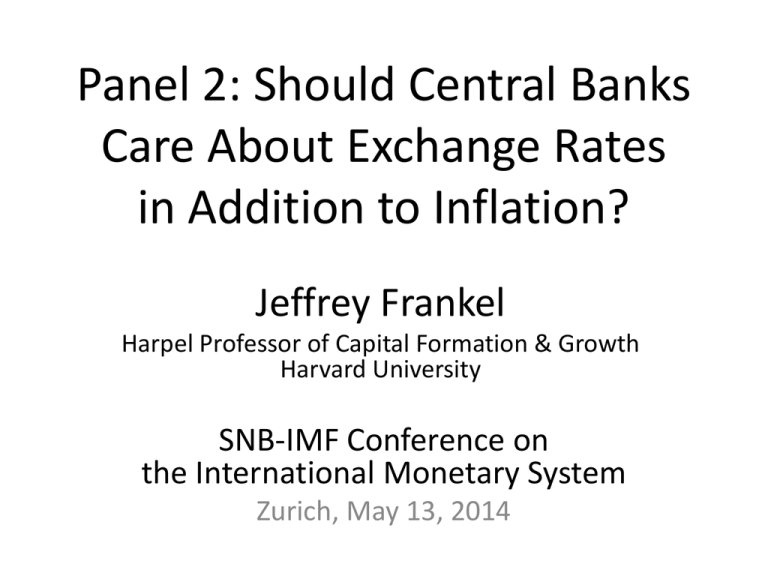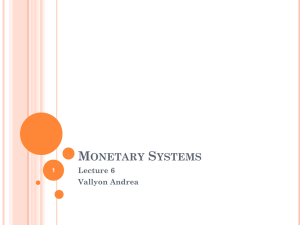Should central banks care about the exchange rate?
advertisement

Panel 2: Should Central Banks Care About Exchange Rates in Addition to Inflation? Jeffrey Frankel Harpel Professor of Capital Formation & Growth Harvard University SNB-IMF Conference on the International Monetary System Zurich, May 13, 2014 Questions • Should central banks care about the exchange rate? – In large countries? – In small open countries? • What purpose should reserves serve? • If the exchange rate is not to be the anchor for monetary policy, what is? Should central banks care about the exchange rate? Yes. – That includes inflation targeters. • But it’s different for different countries: – No single regime is right for all. • Start with large countries. Large economies like the US, euroland & Japan • should float freely most of the time. • But even they should occasionally worry about the exchange rate if it has gotten too far out line, – perhaps once a decade or so: • $ in 1985 (too high), • ¥ in 1995 (too high), and • € in 2002 (too low). – Analogous to those rare times when asset markets get far out of line. – In such cases intervention can help set the markets back on the right track. If I were running the ECB, as of 2014… • I would pursue QE • by buying US bonds, not € bonds . • Why? – (1) If the ECB buys € government bonds, Germany’s Constitutional court may say it exceeded its legal mandate. – (2) The likely side-effect, depreciating the euro, would help adjustment in the euro periphery. • I realize some others might fear reigniting “currency wars,” i.e., competitive depreciation. Smaller countries Very small, very open, economies will continue to want to fix their exchange rates, in most cases. Most countries are in between, particularly middle-sized middle-income countries. • Most of these countries should have intermediate exchange rate regimes, – neither firm fixing nor free floating. – They include band & basket arrangements. Distribution of EM exchange rate regimes The biggest rise is in the “managed float” category Distribution of Exchange Rate Regimes in Emerging Markets, 1980-2011 } (percent of total) Atish Rex Ghosh, Jonathan Ostry & Mahvash Qureshi, 2013, “Exchange Rate Management and Crisis Susceptibility: A Reassessment,” International Monetary Fund Annual Research Conference, Nov.. So I reject the Corners Hypothesis. But Stan Fischer has a good point: giving speculators a target to shoot at it is often a losing proposition , • such as the boundary of a declared band. • Perhaps we could agree on the usefulness of a particular intermediate regime, a systematic sort of managed floating: • A rule could say that for every 1% of Exchange Market Pressure, the central bank takes x % as an appreciation of the currency and (1-x) % as an increase in reserves (relative to the monetary base). – This arrangement, though rather obvious, has seldom been formalized. – The parameter x calibrates exchange rate flexibility, • and can range from 0 (fixing) to close to 1 (full flexibility). – Thus one can have ½ monetary independence + ½ exchange rate stability. Systematic managed float (“leaning against the wind”): Turkey’s central bank buys lira when it depreciates, and sells when it is appreciates. Kaushik Basu & Aristomene Varoudakis, Policy RWP 6469, World Bank, 2013, “How to Move the Exchange Rate If You Must: The Diverse Practice of Foreign Exchange Intervention by Central Banks and a Proposal for Doing it Better” May, p. 14 Example: Renewed inflows in 2010 in Latin America were reflected mostly as reserve accumulation in Peru, but as appreciation in Chile & Colombia. more-managed floating less-managed floating Source: GS Global ECS Research In Asia Korea & Singapore in 2010 took the inflows mostly in the form of reserves, while India & Malaysia took them mostly in the form of currency appreciation. more-managed floating less-managed floating GS Global ECS Research Systematic managed floating • refutes the corners hypothesis, – but without violating the Impossible Trinity, – without capital flow management measures (CFMs), – and even without giving speculators a line to shoot at. ≈ what some central banks do anyway. Attempts at econometric estimation Gustavo Adler & Camilo E. Tovar, 2011, “Foreign Exchange Intervention: A Shield Against Appreciation Winds?” IMF WP 11/165. Jeffrey Frankel & Daniel Xie, 2010, “Estimation of De Facto Flexibility Parameter and Basket Weights in Evolving Exchange Rate Regimes,” Amer.Econ.Rev. 100, May. What purpose should reserves serve? • Yes, the precautionary motive is one purpose. • Consider the Global Financial Crisis of 2008. – Analysis of which countries got badly hit in 2008-09 and which did not: the single best predictor was reserves, – Frankel & Saravelos (2012). – This was the same Early Warning Indicator that also had worked in the most preceding studies of earlier crises. – Two qualifications: • (i) Some researchers did not find the same thing – Olivier Blanchard, in particular; and • (ii) Reserves didn’t work as well as Warning Indicators in the 2013 taper tantrum. • But there are other reasons to add to its fx reserves, besides the precautionary motive . • Dampening appreciation is one. If the exchange rate is not to be the anchor for monetary policy, what is? • The need for an alternative anchor for monetary policy led many countries to Inflation Targeting (IT), – after the currency crises of the late 1990s pushed them away from exchange rate targets. • IT was in many ways successful. • One problem with IT: exogenous supply & trade shocks. – Remember the textbook maxim that the exchange rate should accommodate terms of trade shocks. – If IT is interpreted in terms of the CPI, in theory it doesn’t allow the exchange rate to rise & fall with the terms of trade. – For oil importers, when the world price of oil goes up, a literal CPI target says to tighten monetary policy enough to appreciate the currency, • the opposite direction from accommodating the adverse trade shock. A case for Nominal GDP Targeting • NGDPT is more robust with respect to supply shocks & terms of trade shocks. – That is, compared to the alternative of IT. – If the alternative is a money target, NGDPT is more robust with respect to velocity shocks. – If the alternative for a threshold is the unemployment rate, NGDPT is more robust with respect to • shocks to the labor force participation rate, – as the Fed faced last year, and • shocks to labor productivity, – as the Bank of England has faced. NGDPT • Last point. The proponents of Nominal GDP Targets have focused on the biggest countries. • But middle-size, middle-income countries are better candidates. • Why? They suffer bigger supply shocks & trade shocks. • NGDPT should be considered as a serious alternative to IT & exchange rate targeting. Trade & Supply Shocks are More Common in Emerging Markets & Low-Income Countries IMF SPRD & World Bank PREM, 2011, “Managing Volatility in Low-Income Countries: The Role and Potential for Contingent Financial Instruments,” approved by R.Moghadam & O.Canuto











